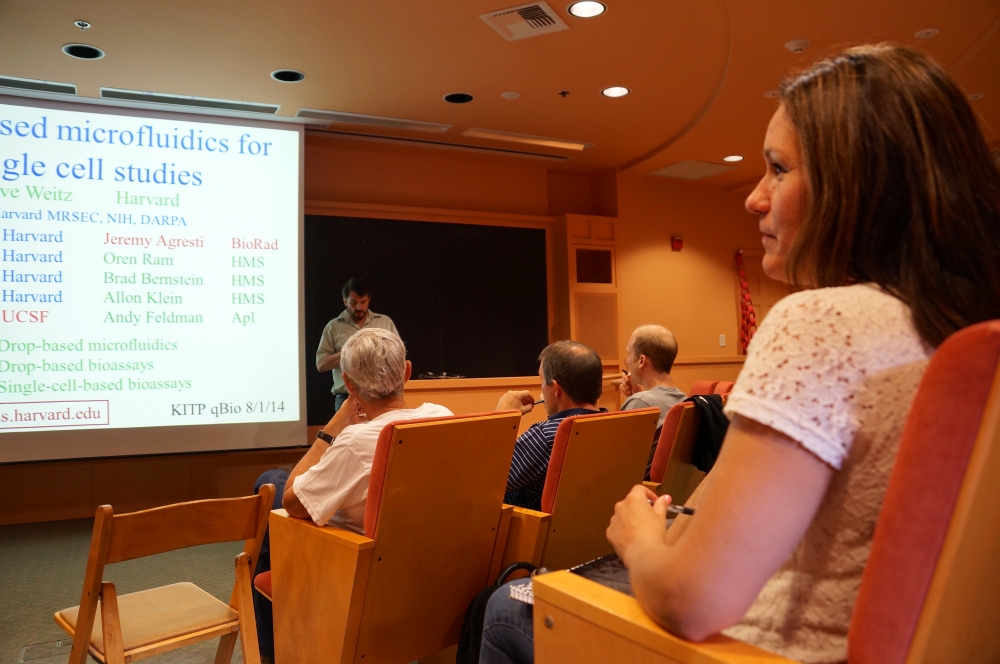Teaching the Teachers
While many teachers take the summer off, educator JulieAnn Villa uses the time to go back to school. For Villa, summer affords the perfect opportunity to learn ways of enhancing the science research course she teaches at Niles West High School in Skokie, Illinois.
For two weeks in July she was one of four teachers in residence at UC Santa Barbara’s Kavli Institute for Theoretical Physics, all funded through a generous donation from the Wyatt Technology Corporation. Villa spent her days attending lectures highlighting “The Evolution of Drug Resistance,” one of KITP’s current programs; and participating in informal discussions and labs with researchers, postdoctoral scholars and professors.
According to Villa, the experience was completely different from any other continuing education program she has attended. “Now I see where science is going,” she said. “Watching some of the discussions, it became evident that you really have to be bold and realize that science is an exchange of ideas.
“I don’t think that the typical student sees that science is about defending an idea per se,” she continued. “They think it’s about memorizing facts or getting the right answer. With this experience, I feel like I have concrete evidence for what skills my students should have and what courses they should take.”
The program’s discussion component provides both an arena to debate existing ideas and an incubator for nurturing new ones. “I love the way these brilliant people interact and the way science is done at KITP,” said Horatio (Nick) Nicastro, who teaches modern physics at Wachusett Regional High School in Holden, Massachusetts. “I can tell my students that these were the brightest people in their field and they’re arguing with each other. They’re great friends. There is great collegiality and great respect, which is something I can really appreciate and take back to the classroom.”
Nicastro and two other teachers in residence participated in “Dynamics of Planetary Interiors,” another KITP program. All of them saw ways to apply parts of what they learned in their classrooms.
“Some of it is so high-level that I’m not able to use it in my teaching, but basic ideas about seismology and geodynamics and some of the magnetic field materials I can apply at a basic level to my class,” said Nicastro. As an example, he cited Hooke’s Law, a principle of physics that states that the force needed to extend or compress a spring by some distance is proportional to that distance. “Instead of using a typical spring and displacement, now I can talk about structures inside the Earth that are stretching.”
“At these higher levels, the math and the basic ideas are still things we talk about in an introductory-level class,” said Ryan Strickland, who teaches science at Southern California’s Idyllwild Arts Academy. “Obviously the math gets more complex and the basic ideas get taken much further, but it still boils down to the same basic principles taught in the beginning. It’s interesting to see that it works that way in upper-level physics.”
According to Thomas Jacobson, the opportunity to see what researchers are doing provided valuable insight into the application of science and mathematics. “All the math I ever took, they use,” said Jacobson, who teaches physics and geophysics at Hinsdale South High School, 20 miles southwest of Chicago. “All the earth science knowledge, they use. All the engineering knowledge, they use. All the physics knowledge, they use.
“I thought it was really important for me to be exposed to where all this is eventually used, to know that there is a use and that I’m not just teaching it because it’s in the curriculum,” he continued. “Even if students aren’t going to use it, at least I can tell them how and where people do and perhaps create a bit of appreciation for it.”
As part of the KITP program, the teachers in residence visited the nearby Dos Pueblos Engineering Academy (DPEA). DPEA is the brainchild of its director, alumnus Amir Abo-Shaeer, a MacArthur “genius grant” recipient.
“Dos Pueblos was awesome,” said Strickland. “I especially liked how engineering and creativity were combined in each project because people often forget that high-level science and engineering require a great deal of creativity. I found the projects at Dos Pueblos to be very applicable for my students.”
Villa was impressed with DPEA’s marketing and how its students take ownership of different aspects of the program. “Those are key pieces I am missing,” she said. “I need to create a school culture and a community culture that understands what my science research class does and celebrates the students’ accomplishments.”
“Having a small manufacturing background, I find it amazing how much DPEA students get exposure to the process of creating something from beginning to end,” Jacobson said. “Seeing that something like that is possible is very inspiring for a teacher.”
Nicastro agreed. “Programs such as these, driven by teachers, continually renew my faith in an aspiring educational system — even after 42 years of teaching,” he added.
The teachers-in-residence program grew out of town hall meetings with participants during KITP’s 2013 and 2104 annual teachers’ conference led by KITP Director Lars Bildsten and Deputy Director Greg Huber. “High school teachers who attended were themselves the catalysts for this new program,” Huber said.
“The goal of our teachers-in-residence program is to expose high school teachers to topics in modern physics,” he added. “The complete scope of current physics is very hard to define, but we are uniquely positioned in this respect because KITP’s activities are at the forefront of defining what modern physics is.”




